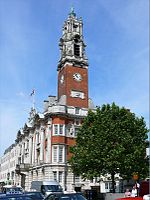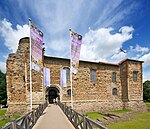St Martin's Church, Colchester
Church of England church buildings in Colchester (town)English Gothic architecture in EssexEnglish churches with Norman architectureGrade II* listed churches in Essex

St Martin's Church is an active Orthodox church, in the Antiochian Archdiocese of the British Isles and Ireland, in the city of Colchester, Essex, England. It is recorded in the National Heritage List for England as a designated Grade II* listed building. The church stands in the centre of the city, near the town hall.
Excerpt from the Wikipedia article St Martin's Church, Colchester (License: CC BY-SA 3.0, Authors, Images).St Martin's Church, Colchester
Quakers Alley, Colchester
Geographical coordinates (GPS) Address External links Nearby Places Show on map
Geographical coordinates (GPS)
| Latitude | Longitude |
|---|---|
| N 51.8909 ° | E 0.8994 ° |
Address
St. Martin
Quakers Alley
CO1 1HN Colchester
England, United Kingdom
Open on Google Maps










